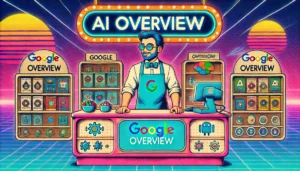7 Smart Steps to Start Your Business AI Transformation (Without Getting Overwhelmed)
“We need to implement AI.” If you’re a business owner or leader, you’ve probably heard (or said) this phrase recently. But where do you start? With vendors promising AI solutions for everything from customer service to operations, the path forward can feel overwhelming. The good news? You don’t need to transform everything at once. Our…
“We need to implement AI.”
If you’re a business owner or leader, you’ve probably heard (or said) this phrase recently. But where do you start? With vendors promising AI solutions for everything from customer service to operations, the path forward can feel overwhelming.
The good news? You don’t need to transform everything at once. Our experience helping businesses navigate AI adoption has shown that a structured, step-by-step approach not only reduces risk but actually delivers better results.
Here’s your practical roadmap to starting your AI transformation journey:
1. Know Where You Stand: The Smart Site Assessment
Think of this as your AI transformation GPS. Before rushing to implement new technologies, you need to know your starting point. Just as you wouldn’t start a cross-country trip without checking your vehicle and planning your route, you shouldn’t start AI transformation without understanding your technical readiness and opportunities.
Quick win: Get a professional evaluation of your current tech stack using industry-standard tools like Screaming Frog. This reveals immediate opportunities for improvement.
Why it matters: Most businesses are surprised to learn they’re either closer to AI-readiness than they thought, or they’re building on shaky technical foundations. Either way, knowing saves time and money.
Pro tip: Focus the assessment on areas where AI can deliver immediate value. For most businesses, this means customer interactions and content management.
2. Fix Your Foundation: Website Optimization
Would you build a smart home on crumbling foundations? The same principle applies to AI transformation. Most traditional websites are built for human consumption only, with complex layouts and inefficient code that create significant obstacles for AI systems. Getting these basics right first saves enormous headaches later.
Quick win: Clean up technical debt and optimize your existing content structure. This alone can improve your site’s performance.
Why it matters: Our testing shows that traditional websites are incredibly inefficient for AI processing. A single blog post that requires 1,737 tokens in a traditional format can be reduced to just 799 tokens with proper optimization. That’s 54% more efficient!
Pro tip: Start by cleaning up your content management system. Remove unnecessary plugins and streamline your site’s architecture.
3. Separate Content from Presentation
This is the secret sauce of AI-ready websites that most businesses miss. Traditional websites tangle content, design, and functionality together, making it nearly impossible for AI to efficiently process information. Modern AI-ready architecture takes a different approach, treating content as a separate, accessible resource.
Quick win: Start organizing your content in a structured, API-first format, separating what you say from how you display it.
Why it matters: When content is trapped in complex layouts and page builders, AI systems struggle to process it efficiently. Clean separation makes your content instantly available for AI applications.
Pro tip: Consider moving to a modern framework like Next.js that naturally separates content from presentation. Your future AI initiatives will thank you.
4. Build Your Knowledge Base
Your business’s collective knowledge is its most valuable asset. Make it AI-accessible. Every business has accumulated valuable information spread across documents, emails, and employees’ heads. Organizing this knowledge systematically is crucial for effective AI implementation.
Quick win: Document your top 20 most frequently asked questions and their answers in a structured format.
Why it matters: This becomes the foundation for AI-powered customer service and internal operations. It’s also surprisingly valuable for human team members!
Pro tip: Start with customer-facing information before moving to internal processes. The immediate impact on customer service can help build momentum for your AI initiatives.
5. Start Simple: External AI Integration
Now we’re getting to the fun part – actual AI implementation. This is where your preparation starts paying off, and you can begin introducing AI-powered features that directly impact your customers’ experience. Starting with external applications gives you valuable experience while delivering immediate customer value.
Quick win: Implement basic AI chat capabilities through your optimized website. Start with simple, focused use cases like FAQ handling.
Why it matters: This gives your team and customers their first taste of AI interaction while providing valuable learning opportunities.
Pro tip: Use a protected business assets layer to keep proprietary information secure while still making it available to your AI systems.
6. Go Deeper: Internal AI Tools
Once you’ve mastered external AI applications, it’s time to look inward. With experience from customer-facing AI implementations and a solid foundation in place, you can begin transforming internal operations. This step often delivers the most significant ROI as it directly impacts operational efficiency.
Quick win: Identify one repetitive task in your business that could be automated with AI. Common examples include data entry, report generation, or basic customer inquiries.
Why it matters: Internal efficiency gains often pay for your entire AI transformation. Plus, happy employees make for happy customers.
Pro tip: Consider implementing Brain-E for internal knowledge management and automation. It’s designed to grow with your AI maturity.
7. Scale Up: Custom AI Development
Ready for the big leagues? This is where AI becomes your competitive advantage. By this point, you have a strong foundation, experience with both external and internal AI applications, and a clear understanding of where custom development can add the most value. This is when AI truly becomes transformative for your business.
Quick win: Start with one department or process for custom AI integration. Choose something that could deliver significant ROI if optimized.
Why it matters: Custom AI development, while more intensive, creates unique capabilities that set you apart from competitors.
Pro tip: Build on the foundation of your earlier steps. The clean architecture and organized knowledge base you created will make custom development much more effective.
Taking the First Step
AI transformation doesn’t have to be overwhelming. Start with a Smart Site Assessment to understand where you stand and what quick wins are available to you. Each step builds on the previous one, creating a sustainable path to AI maturity.
Remember, the goal isn’t to transform everything overnight. It’s to build a foundation for continuous improvement and innovation. The businesses that succeed with AI aren’t necessarily the ones with the biggest budgets – they’re the ones that take a thoughtful, structured approach to transformation.
Your AI journey begins with understanding where you stand. Our Smart Site Assessment can help you identify your starting point and create a clear path forward. Why wait while your competitors move ahead? Take the first step today.
Ready to start your AI transformation journey? Schedule your Smart Site Assessment now and get a clear roadmap for your AI future. Click here to learn more about our assessment process and book your session.








